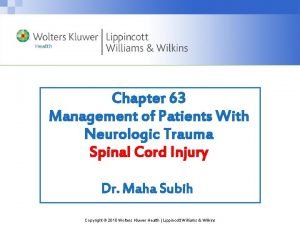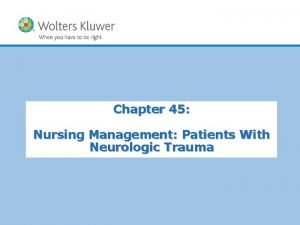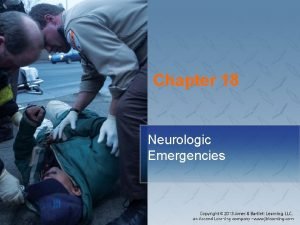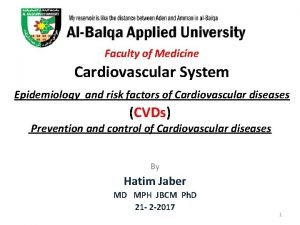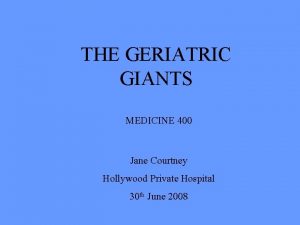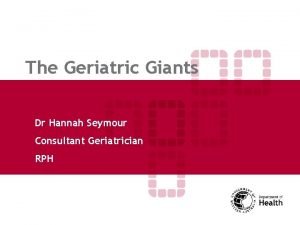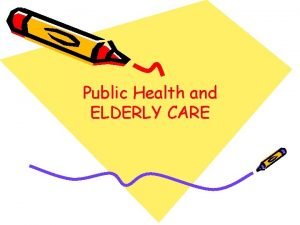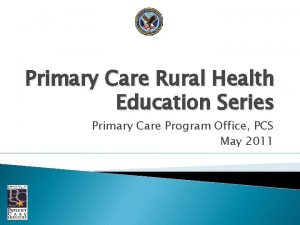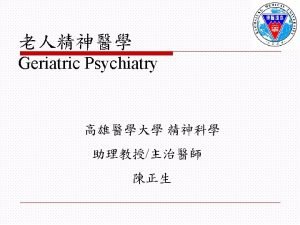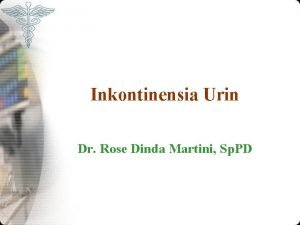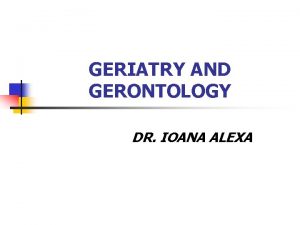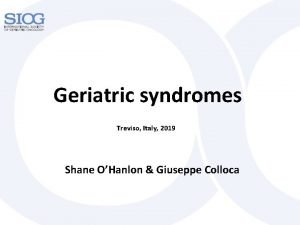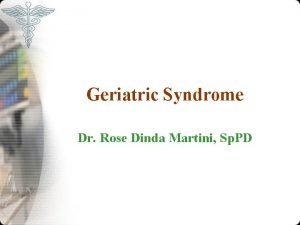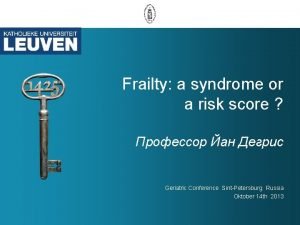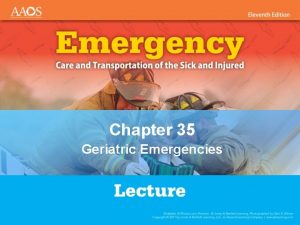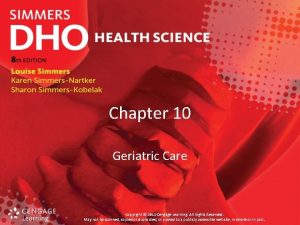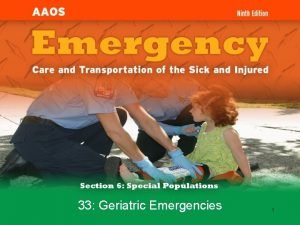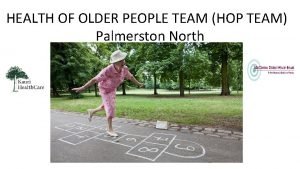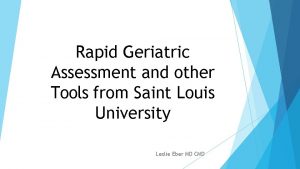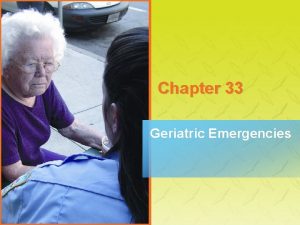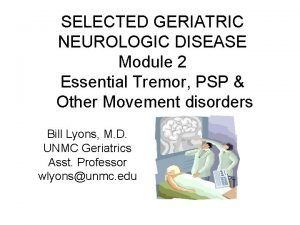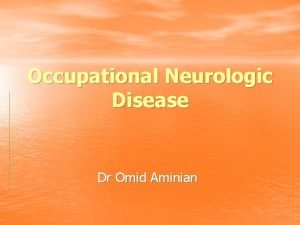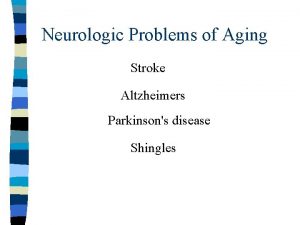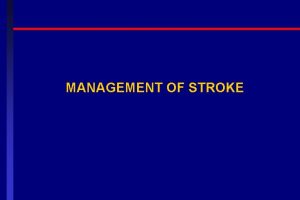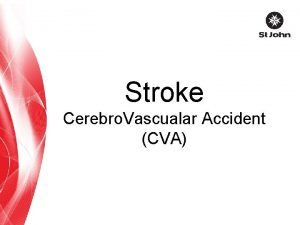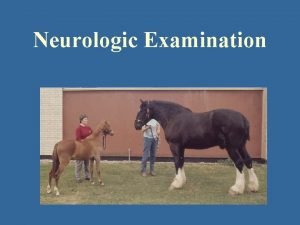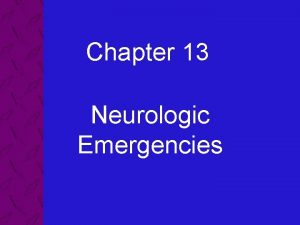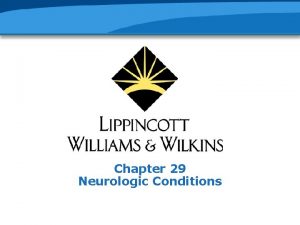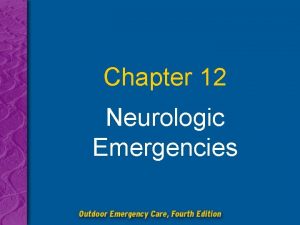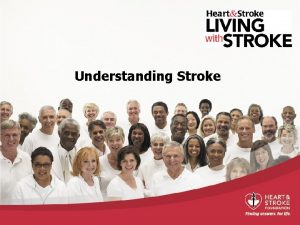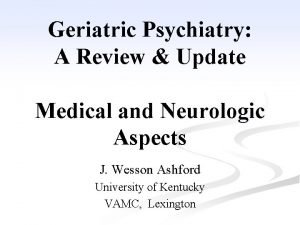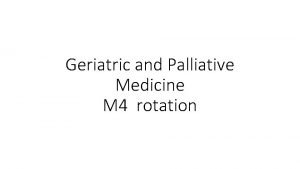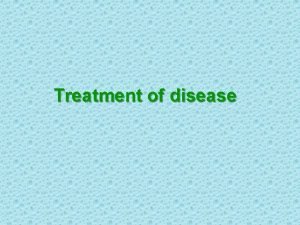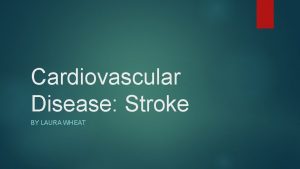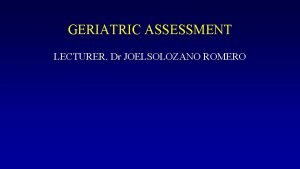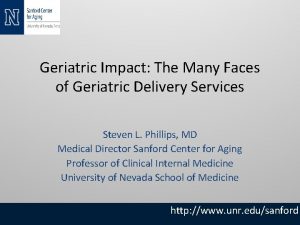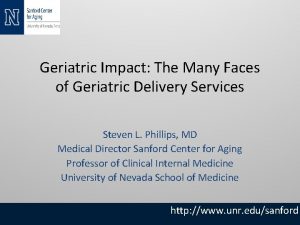SELECTED GERIATRIC NEUROLOGIC DISEASE Module 3 Stroke and

























- Slides: 25

SELECTED GERIATRIC NEUROLOGIC DISEASE Module 3 Stroke and TIA’s Bill Lyons, M. D. UNMC Geriatrics Asst. Professor wlyons@unmc. edu

Objectives Re: Stroke and TIA, upon completion the learner will be able to: 1. Lists the etiologies 2. Describe the diagnostic features 3. Described the evaluation and management.

STROKE • Abrupt neurologic deficit • #3 cause of death in US, #1 cause of disability

STROKE • Older age – Increases risk of death from stroke – Risk factor for recurrence • Predictors of long-term outcome: – Severity of symptoms at presentation – Age

OTHER PREDICTORS OF BAD OUTCOMES • Cardioembolic worse than lacunar • Thrombosis of: basilar artery, intracranial ICA, or MCA • Hyperglycemia (even if not diabetic)

ISCHEMIC STROKES • About 70 -80% of all strokes • Arterial diseases – atherosclerosis, rarely arterial dissection • Embolism – atrial fibrillation, aortic arch, carotid a. , vertebral a. , basilar a. • Hypertension – lipohyalinotic thickening • Hypoperfusion – watershed infarcts • Prothrombotic states – including HRT

HEMORRHAGIC STROKES • About 20 -30% of strokes • Hypertension • Vascular lesions (AVMs, aneurysms, amyloid angiopathy, vasculitis) • Coagulopathy • Hemorrhagic transformation of ischemic CVA • Bleed into tumor

CLINICAL FINDINGS • Sudden neurologic deficit • Motor, sensory, visual, coordination, cognitive, sensorium, language • May see seizures at onset, or nausea/vomiting • Sudden, severe headache in SAH or ICH

VERTEBROBASILAR DISEASE • • • Dizziness or vertigo Headache, vomiting, diplopia Vision loss Ataxia Bilateral numbness/weakness Top-of-the-Basilar: somnolence/stupor, inability to form new memories, poorly reactive pupils, vertical gaze deficits

IMAGING, OTHER STUDIES • Urgent neuroimaging (CT, MRI) essential • Small minority (~5%) acute ischemic strokes visible on CT in <12 hrs • MRI better sensitivity • Suggestion of embolic disease – Suspicious: multiple infarcts, different territories – ECG, echocardiography, rhythm monitoring

DIFFERENTIAL DIAGNOSIS OF STROKE • Postictal (Todd’s paralysis) • Subdural or epidural hematoma • Metabolic (hypoglycemic!) or hypoxic encephalopathy • Brain tumor (primary or metastatic) • Brain abscess

DIFFERENTIAL, cont’d • • Encephalitis Migraine Multiple sclerosis Psychogenic

STROKE COMPLICATIONS • Functional loss from motor, sensory, coordination deficits • Cognitive loss, dementia • Seizure disorder • Depression (affects 25 -40% in first year) • Aspiration (esp from dysphagia, altered LOC) • DVT, contractures, pressure ulcers • UTIs (esp if bladder catheters used)

STROKE TREATMENT • Acute stroke units shown to improve outcomes in ischemic strokes (death, disability, need for institutionalization)

STROKE TREATMENT, cont’d • • NPO until safe swallowing (IVF instead) DVT prophylaxis Monitor BP, don’t rapidly reduce PT, OT, SLP consultations

STROKE TREATMENT, cont’d • Determine stroke subtype by neuroimaging • Thrombolytic or antithrombotic treatment contraindicated in hemorrhagic stroke • Thrombolysis – Improved outcomes in acute ischemic CVA if treated within 3 hrs symptom onset – Contraindications: bleeding diathesis, surgery, etc – Advanced age increases risk of intracerebral

SECONDARY PREVENTION • Cardioembolic – oral anticoagulation • Ischemic, noncardioembolic – antiplatelet agents • Stenosis of ipsilateral carotid artery – Probable benefit from CEA if >50% stenosis – Benefits more pronounced if over 70% stenosis • Manage htn, DM, dyslipidemia, smoking

TRANSIENT ISCHEMIC ATTACK • Classic definition: – Sudden deficit lasting <24 hrs – Vascular origin, in area perfused by specific artery • TIA Working Group alternate definition

TIA, cont’d • Important to identify and treat! – After first TIA, 10 -20% have stroke in next 90 days, half of which occur within 1 -2 days of TIA – Predictors of greater stroke risk: advanced age, diabetes, symptoms lasting >10 min, weakness, impaired speech – Need urgent brain imaging

TIA TREATMENT • Atrial fibrillation – anticoagulation • Noncardioembolic cause – antiplatelet therapy • Carotid disease – CEA for good surgical candidates, 70 -99% stenosis, and TIA in previous 2 years – Consider CEA for 50 -69% stenosis • Risk factors: htn, DM, lipids, smoking….

Post-test question one Consider the case of a 90 -year-old woman with diabetes, congestive heart failure, and mild Alzheimer's disease, who presents to the emergency department. She experienced a sudden episode of weakness involving her right arm and leg, along with difficulty "getting her words out. " The entire episode lasted about 15 minutes, and it occurred about 2 hours before her arrival at the emergency department. A head CT obtained shortly after her arrival in the ED shows only atrophy consistent with her age. All of the following statements regarding this patient are correct except: A. The head CT result rules out ischemic stroke B. The patient's advanced age increases her risk of stroke in the near term C. The patient's symptom duration increases her risk of stroke in the near term D. Her impaired speech increases her risk of stroke in the near term

Correct Answer: A. The head CT result rules out ischemic stroke Feedback: • The answer is (a). The head CT was obtained only 2 to 3 hours after her acute neurologic event. Remember that only 5% of acute ischemic strokes are readily appreciated on CT in the first 12 hours, so her "negative" head CT does not rule this out. The other answers are all true statements, since, in the setting of TIA, advanced age, symptoms lasting over 10 minutes, and impaired speech are all risk factors for suffering a stroke after a TIA. End

REFERENCES • • Aminoff MJ. Nervous System. Chapter 24 in: Tierney LM Jr, Mc. Phee SJ, Papadakis MA. Current Medical Diagnosis and Treatment, 43 rd Edition, 2004. Mc. Graw. Hill, NY. Carey E, Adler J. Parkinson’s Disease and Essential Tremor. Chapter 13 in: Landefeld CS et al. Current Geriatric Diagnosis and Treatment. Mc. Graw-Hill, New York, 2004. Siderowf A, Stern M. Ann Intern Med 2003; 138: 651658. Rao G et al. JAMA 2003; 289: 347 -353.

REFERENCES, cont’d • Stacy M. Progressive Supranuclear Palsy. Chapter 16 in: Adler CH, Ahlskog JE. Parkinson’s Disease and Movement Disorders. Humana Press, Totowa, NJ, 2000. • Leira EC, Adams HP. Cerebrovascular Disease. Chapter 18 in: Landefeld CS et al. Current Geriatric Diagnosis and Treatment. Mc. Graw-Hill, New York, 2004. • Weinberger J. Clinical Geriatrics 2004; 12: 48 -54. • Dobkin BH. N Engl J Med 2005; 352: 1677 -1684. • Flint AC, Smith WS. Stroke Rounds 2004; 10(2).

REFERENCES, cont’d • Savitz SI, Caplan LR. N Engl J Med 2005; 352: 26182626. • Albers GW et al for the TIA Working Group. N Engl J Med 2002; 347(21): 1713 -1716. • Johnston SC. N Engl J Med 2002; 347(21): 1687 -1692. • Castillo J et al. Stroke 2004; 35: 520 -527.
 Management of patients with neurologic trauma
Management of patients with neurologic trauma Management of patients with neurologic trauma
Management of patients with neurologic trauma Chapter 18 neurologic emergencies
Chapter 18 neurologic emergencies A 41 year old man presents with slow irregular breathing
A 41 year old man presents with slow irregular breathing Anterior stroke vs posterior stroke
Anterior stroke vs posterior stroke Cvds
Cvds Communicable disease and non communicable disease
Communicable disease and non communicable disease C device module module 1
C device module module 1 Geriatric giants
Geriatric giants Giant of geriatric
Giant of geriatric Geriatric syndrome
Geriatric syndrome Objectives of geriatric care
Objectives of geriatric care Va geriatric scholars program
Va geriatric scholars program Geriatric psychiatry definition
Geriatric psychiatry definition Dr rose dinda martini
Dr rose dinda martini Geriatric giants
Geriatric giants What is geriatric syndromes
What is geriatric syndromes 14i geriatric giants
14i geriatric giants Geriatric syndrome
Geriatric syndrome Chapter 35 geriatric emergencies
Chapter 35 geriatric emergencies Chapter 10 geriatric care
Chapter 10 geriatric care Gems geriatric diamond
Gems geriatric diamond Palmerston north geriatric
Palmerston north geriatric Rapid geriatric assessment
Rapid geriatric assessment Gems diamond geriatric
Gems diamond geriatric Centrum geriatric
Centrum geriatric
